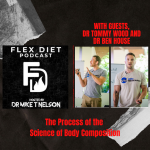Hi listeners. I’m back after a few weeks in Costa Rica. Jodie and I spent time working on a couple of projects with a few days of kiteboarding thrown in. Today’s episode answers a great question. If you only had four weeks to get into really good shape, what exactly would you do?
Episode Notes
- I cover my basic assumptions regarding who this is for
- Lifting component: what I would do and how often
- Cardio component
- Nutrition
- Fasting
- Hydration
- Supplements
- Sleep
- Other
The Flex Diet Podcast is brought to you by the Flex Diet Certification. Go to flexdiet.com for 8 interventions on nutrition and recovery. Join the waitlist, which puts you on the daily newsletter, and you’ll be the first to be notified when the certification opens again.
Or watch on YouTube:
Rock On!
Dr Mike
P.S. Catch up on any missed Flex Diet Podcasts!
Transcript:
SUMMARY KEYWORDS
grams, rower, week, higher, little bit, minutes, lifting, bit, day, loss, form, rep range, run, assuming, flex, calories, meals, caloric deficit, assumption, accessory
SPEAKERS
Dr. Mike T Nelson
Dr. Mike T Nelson 00:01
Hey there, what’s going on? It’s Dr. Mike T. Nelson here back on the podcast after a little bit of a break. My wonderful wife and I were off in Costa Rica for about 16 days down there working on a project got some time to hang out, chill out, relax, got a couple days kiteboarding at the Blue Dream and northwest Costa Rica. Shout out to Nicholas and those guys awesome place if you ever get the chance to go down there. But highly recommended. It was crazy windy, got blown off on my eight meter ended up having to rent a six meter kite which is so tiny. So we are back. And the episode today, I’m going to talk about if you had only four weeks to get in really good shape, what exactly would you do? And a lot of the principles that that will be based on I cover in the flex diet certification. If you want more information on the flex diet certification, which will open up again, go to flex diet.com xdt.com. And there’ll be a way to get on to the waitlist that’ll put you on to the daily newsletter, where you get all sorts of crazy fitness writing for me on how to increase hypertrophy, better body composition, all without destroying your health in the process. So go to flex diet.com Fl exdet.com. So the question today I’m going to cover is from Gareth he asked me to contribute to this for a team and compilation. But unfortunately, I was in Costa Rica and just ran out of time to get back to him on it. But it was such a good question. I wanted to give him credit for coming up with this and invited me to do the review. I still wanted to share my thoughts for you here since I had everything all written out. The question is, if the average meathead wanted to get in the best possible shape within four weeks, last minute beats vacation, they’re feeling a little fluffy. What would you have them do zero limitations? I love the question. I thought it was very good. The first thing I will add for the context. So without context and constraints, it’s going to be hard to give a semi specific answer. So my assumption here is this could be a male or female, who’s been training for about two to three, maybe even four years. So intermittent lifter used to volume assumingly, they’ve got their nutrition pretty good on tap, sleep is good, recovery is good, they’re healthy, those kind of parameters. And for this four week period, since there are no limitations, I did not have a normal limit on time, or equipment for them. So we are assuming that they can have a flexible lifestyle, they can dedicate as much time as they need to doing this. And we know it’s for a short period of time, so it’s only for four weeks. So I broke this down is the first part would be the lifting component. I would set them up as some type of kind of like a bastardized conjugate programming, they would do most of their lifting Monday, Wednesday, Friday, maybe Saturday dependent upon how the recovery and heart rate variability looked. And I would take a big compound lift for strength, that would be the first exercise and the rest would be a little bit more in kind of the classic hypertrophy range. So Monday I would do bench press in the three to five rep range, and then have them do some accessory work after that. For volume, it really depends on the individual. It’s hard to give a volume spec but I’d be looking at three to four sets probably after they’ve been warmed up benchpress and then maybe three to five accessory exercises. Again, that part is really hard to give general information without doing specific testing heart rate variability, see how they can recover. Wednesday then I would have them do some type of squat work plus accessory squat again would be in the three to five rep range. My preference would be front squats just because it’s harder to screw them up.
Michael Nelson 04:57
But if you have access to Doing something like a zurcher, where you’re holding in your elbows, or a safety squat bar, or if you’re very accomplished and comfortable with the back squat, and it doesn’t give you any issues, you can definitely do that too. So be a squat, three to five rep range. And then accessory, primarily more lower body, though with accessory stuff, you could throw in some chin ups and other items like that in there, too. So what I’m thinking about is Monday, Wednesday, Friday, trying to activate as much muscle as possible. But I still want to have a strength stimulus because I think that’s going to hold on to as much muscle as possible. They may build a little bit of muscle during this four week phase, but most of it I’m just trying to think good quality work, maybe add a little hypertrophy. But we want a strong stimulus there, because most of it is going to be fat loss based that we don’t want any loss of muscle mass. Friday, again, deadlift would be this time, and this could be conventional. Could be Sumo could be Jefferson. whatever fits your fancy trap bar is one of my favorite go twos for sure farmer’s bar deadlifts you get the idea. Three to five rep max again, again, all these would be done with the one or two re are so reps and reserve so you’re not going all the way to failure. And then after that, just another accessory work again, mostly in the eight to 12 rep range. Saturday, if they’ve got good recovery, I would do some type of strongman medley. Again, this may be dependent upon what they have access to for equipment. But I love things like farmers walks are great. Even sledgehammer work is great. Some sled poles can be good, especially reverse sled drags, things that are a little bit more in the concentric only phase, like getting a lot of high quality work in kettlebell work can be in there to get it doesn’t always have to be concentric only type stuff that just depends on how sore and how beat up they are. If they don’t have access to any strongman stuff, I would have them do some form of rowing on the concept to rower that’s a really good way to get in some higher intensity work. They’re also some little bit different movement patterns to Sunday would be an off day. And then on Tuesday and Thursday, ideally, I’d have them do 20 minute capacity on the rower, they could do it on a bike, they could do it on other equipment if they needed to, after doing a rollover, ideally, I’m assuming they’re in shape enough to do a five k at around 2021 minute 22 minute mark. So they would do that on Tuesday and Thursday, rpm that would be around an eight. So it’s going to be hard but not shouldn’t be bleeding out of your eyeballs for five minutes when you’re done with that. So it’s definitely not a max. So we’ve got a lifting and then we alternate with cardio, I find that that gives their nervous system a little bit of a chance to recover. still get in some good quality work, keeping them cardiovascular performance, both for recovery ability from one session to the next. Yeah, you do burn some calories there but I’m primarily interested in the cardiovascular adaptations. Each morning I would have them do some type of fasted nasal only breathing. This could be really as simple as just six minutes on the rower trying to hit at least 1500 meters at a minimum. And then 1020 minutes. nasal breathing on a bike works well. I find you can do it on the rower too. But I find the rower for a lot of people. This is just a based on anecdotal naxi testing tends to be more like strength training, you can get fancy and do what I call unloaded, rolling, retake the damper and put it all the way down. So it’s much easier that can help a little bit. I find the bike doesn’t beat people up as much if you’re doing higher frequency with it. Again, with that, yeah, we’re burning some calories, we’re not gonna see a huge caloric drain from that. But I just find that day to day performance is usually better having some type of movement in there. And we are burning some more calories but we’re not trying to completely obliterate someone or not making it all super high intensity, just easy stuff they can recover from most of their lifting then would be in the afternoon. And again, this is only for four weeks, and this assumes that someone already has a pretty good aerobic base developed. Walking for NEET. Again, this is a perfect scenario here which doesn’t exist. It’s just a mental exercise to give you some framework, probably hitting around 10,000 steps per day. And then that is a little bit of an arbitrary number really depends upon where they were before, if they were hitting 10,000 steps a day, already doing some am cardio and more weight neutral, I probably would bump that up to maybe 12,000 13,000. Again, this is assuming they have time to do it. And again, this is a perfect scenario, they’re getting their need in movement, definitely good. So that covers most of the training. For nutrition. Again, nutrition is going to be very individually specific. But in this case, I would target higher protein. So looking at around one gram per pound of body weight. So there are 200 pound mammal, looking at around 200 grams per day. Normally, I would divide that up then by their number of meals. So if they’re eating four meals, you’re going to get about 50 grams of protein. And each one part of this is higher than the point seven grams per pound of body weight, or that’s what actually recommended the flextight cert. A reason for this is they are going to be in a caloric deficit, right, because they’re going to try to lose fat. And we want something with a little bit higher satiety. So I found that that works quite well for that. Fat, I would say that around 80 grams per day. So that’s definitely on the lower side, but it’s not stupid low, we’re we’re gonna run into issues with hormonal profile, things of that nature. For carbs, I would scale carbohydrates down each week. So if we assume that their weight neutral, a hypothetical amount of 300 grams of carbs per day, would probably drop 75 per week. Again, that’s, that’s a guess. But that would have to be changed depending upon the rate of loss that we’re seeing. But this would look like Week One would be 300 grams every day, week to 225 grams, weeks, 350 grams, week four, technically, you’d be at 75 grams that I probably wouldn’t go much below a threshold of around 100. I just find if you’re in the 50 to 100 grams of carbohydrates per day, that’s kind of the metabolic no man’s land, where it’s really, really hard to recover. But you’re not low enough that you’re not going into a ketogenic type state and having another fuel to use. So I may cap that at around 100. Now, again, this really depends upon their rate of loss, and how much they have to lose, you know, ideally, without, you know, just demolishing their health or making them feel completely horrible before they go on a trip. I’m looking at one to two pounds of scale weight per week. Now, again, that could be loss of glycogen, it can be a loss of water, and maybe higher than that dependent upon, you know what size a person we’re dealing with. And then they would have carbohydrate up before their pictures, if they’re doing a photo shoot or their trip. Usually, if they’re doing a trip, their carbohydrate load up is going to be their first big meal on their trip. Depending upon rate of loss, I probably will include some fasting. This is under the assumption that they are able to fast and they can do a 19 to 24 hour fast without a huge issue. I would do that either on the Tuesday or Thursday. So I would match that to the moderate to lower intensity carbohydrate date. water consumption around two liters per day, I do like adding a one to two packets of element. Simple thing I use is if they’re drinking too lot two liters of extra water per day, this isn’t an addition to food. I just add one packet of element which is a high sodium electrolyte drink to each leader. So two liters of water per day, that would be two packets total of element per day. Again, the assumptions here are you’re in normal environment, you’re not sweating a ton. If it’s a fasting day, that’s probably going to be adequate. If it’s other days and you’re adding a lot of salt to your food. Yeah, you may only need one packet somewhere around there. Again, part of this too is to offset hopefully some hunger because you’re going to be drinking more fluid because you are going to be in a caloric deficit. In terms of supplements, nothing crazy really, as I mentioned element, which is just an electrolyte supplement. And again, the assumption there is this as a healthy person who doesn’t have high blood pressure or any other health issues. Protein Powder if they needed to replace one of their meals or creatine monohydrate five grams per day. multivitamin fish oil like Around two grams per day. And as I mentioned, element for electrolytes, those would be the basic ones, a couple of you can add that might be useful caffeine as needed before some of the heavier workouts just to make sure performance stays good. Do like magnesium before bed. If you’re using it before bed, the form doesn’t make as much of a difference, you can use a cheaper citrate form, amount. Yeah, 100 to 200% of the RTA. So if you look at the label probably go a little bit higher. That covers the different amounts of magnesium and the different types and how much of it is actually elemental magnesium versus bound to something else. Yeah, so in your your higher quality magnesium sources work fine. Again, if you’re just using a before bed, you could use magnesium citrate, it’ll be fine. If for some odd reason, you find you’re having issues to run to the bathroom, just cut down the dose, or use a different form like glycinate is a pretty good form. Sleep as much as humanly possible. Maybe if you’re having sleep regulation issues, you can use this very small amount of melatonin. For some really high stress individuals, I found that a high dose of CBD cannabidiol can help. Now the data on that is pretty mixed. But I’ve noticed with some people that tend to run in the higher anxiety side 200 to 300 milligrams can help. Again, that’s a pretty high dose. Some people respond well to it, other people who doesn’t make a huge difference. I like using it before bed. And ideally, you get a 20 to 40 minute nap post training or post lifting, I find that that can help quite a bit, you know, fast just down regulate for 10 minutes, get some breathing in long exhales even if you don’t fall asleep, I find that that can help quite a bit. We’re looking for around a 90% compliance on all of it, which is a pretty high, ask, but it’s not 100%. So if you’re hitting most of your meals, you could screw up 10% of them, it probably still gonna be fine, right? I haven’t noticed a huge difference between 90 and 100% compliance. Although you could argue for this, if there’s no limitations, and we’re trying to extract everything possible, we can maybe 100% compliance. But again, we’re also trying to be somewhat realistic with everything here. Now, again, this is a little bit hypothetical. But based on the principles that I use with one on one clients, if they had four weeks to do it, that’s kind of a rough outline of what I would do. That’s going to cover most things. Obviously, if it’s an individual, you’d want to customize that. We’d be looking at daily heart rate variability, to keep an eye on stress to make sure we don’t run them right off a cliff and have them implode on week two, before they get all the way through. We’ve been monitoring calories to see what the rate of loss is. So of course, they need to be in a caloric deficit, be monitoring performance, too, we don’t want to see performance take a big nosedive, because then we risk losing some muscle mass. So there you go. For this client, if they had four weeks to get in last minute shape, trying to preserve as much muscle as possible, maybe add a little bit and working primarily on more aggressive fat loss. That’s what I would do. So thanks, guys for the question. That was a fun one. And if you want more information on nutrition and some basic exercise stuff, go to the flex diet.com Fl exdt.com you’ll be able to get on the waitlist there. And we will notify you the next time that it opens. That’ll also put you on the semi daily free insider newsletter. And there you go. So thank you so much, greatly appreciate it. We are back we’ve got a bunch more guests coming up a few more solo episodes like this. Thank you once again for listening. If you could leave us a review, are subscribed on whatever your favorite listening app is. We would really appreciate it. Thank you so much. Talk to you again soon.





